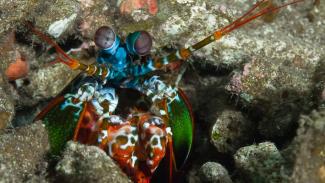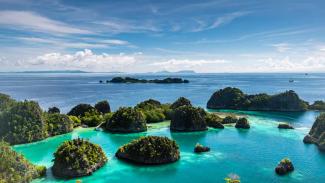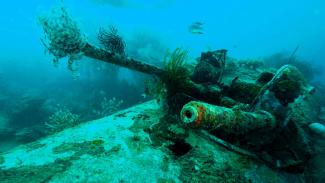Where to see Sharks, Manta Rays and other pelagic species
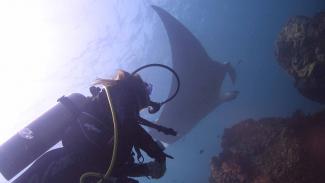
There's no other thrill that quite compares to an encounter with an apex predator or gentle giant. For some, diving with Sharks is the ultimate bucket list experience. For others, it is swimming with Manta Rays.
From Myanmar in the west to PNG in the east, South-east Asia cannot fail to disappoint lovers of majestic pelagic species looking for that ultimate diving encounter.
To help you to be in the right place at the right time, read on and discover our shortlist of bucket list big fish dives in Asia.

What is a pelagic species?
Before we get to our recommendations though, you all know what we mean by a pelagic species, right? Ok, not necessarily. Let's cover that first....
The pelagic zone is the term used to describe the area of water in an ocean or sea that is not near to the seabed or the coast, you might call it the 'big blue'. The animals that travel through these waters are often known as pelagic species. Because of the environment they tend to inhabit and the distances they travel, they can be some of the largest and most impressive animals in our oceans, such as Manta Rays and Whale Sharks.
That does not mean they spend their whole lives out in pelagic waters. Divers and snorkelers often have the best chance to encounter these iconic species when they come closer to a reef or landmass. The may do so to hunt for prey or to be cleaned, providing the ideal opportunity for us scuba divers or snorkelers to get a glimpse.
Iconic pelagic species
There are many pelagic species. The list includes Sailfish, Tuna, Mackeral and even the likes of Sardines. Certain species are sought out by divers and snorkelers however for their elegance, their sheer size, or simply their other-worldliness.
Here are a few of the big animals that it is possible to see in the beautiful waters of south-east Asia. Read on to find our top picks for awesome, bucket-list big fish dives...

Tara North
Sharks
Sharks are top of many divers’ bucket lists. These ancient, apex predators have been around for 400 million years and in many ways are the guardians of our oceans and reefs. There are over 500 species of Shark. Some of those most loved by divers are the iconic scalloped Hammerhead Shark that can be seen at Layang Layang, the shy, graceful Thresher Sharks seen in Malapascua, and majestic requiem sharks such as Tiger or Grey Reef Sharks.

Alex Rose

Ben Philli
Manta Rays
Majestic Manta Rays almost need no introduction. Swimming with a Manta Ray as they glide effortlessly through the ocean like a craft from outer space is an experience never forgotten. There are, in fact, two species of Manta Ray, the Reef Manta Ray and the Oceanic Manta Ray. Reef Manta Rays are smaller and aggregate in larger numbers, often inhabiting a smaller area. Giant Manta Rays can measure up to 7 metres from wingtip to wingtip and are great ocean wanderers, travelling vast distances through pelagic waters. Both also visit reefs or sea mounts, often to be cleaned, providing the ideal opportunity to swim or dive with Mantas.

Tara North

Ilse Reis & Jan Noud Hutton
Where to dive or snorkel with Sharks, Manta Rays and more
Now we have run through the most sought after pelagic species for divers and snorkelers, let’s get down to our top tips for where to see them.
This is not an exhaustive list, but we hope points you in the right direction. Based on our experience, we've provided some suggestions fr resorts, liveaboards and dive centers based on experience, all of which can be booked through our partners. Finally, remember these are wild animals. Visiting at the right place and time is no guarantee of a sighting. The journey is part of the adventure...

Thomas Alexander
Malapascua Snapshot
- When to go: Open all year, with best diving conditions from December through to May.
- Marine life highlights: Thresher Sharks, Manta Rays, Critters
- How to reach: Transfers provided from Cebu Airport, but morning or early afternoon to allow time for the 4 hour transfer.
- Prices guide: From as little as USD30 per night plus diving, with better accommodation options between USD65-USD100 per night.
Malapascua, Philippines
This little island just off the northern tip of Cebu in the Philippines has shot to fame in recent years for some of the best sightings of Thresher Sharks in the world. Thresher Sharks are extraordinary as they hunt by whipping their extended tails and stunning prey. These tails also give them an elegance like no other shark. There are actually three species of Thresher Shark, and it is the Pelagic Thresher Shark that is seen around Malapascua for those prepared to get up early. The area also sees manta rays and hammerhead sharks seasonally.
How to dive Malapascua
Malapascua has a range of hotels and guesthouses to choose from, along with some excellent dive centers. For competitive rates and excellent rewards, we recommend to book your accommodation through Expedia. Excellent options for divers include Ocean Vida Dive Resort, the superb Malapascua Exotic Island Dive & Beach Resort or the attractive Beuna Vista Resort & Spa.
You can compare and book Malapascua dive centers through the excellent Dive Booker portal.
Philippines liveaboards also ply the waters around Malapascua on itineraries that also take in other famous dive spots in the region. For the widest choice and a price guarantee, we recommend to arrange your liveaboard adventure through liveaboard.com. The beautiful Philippine Siren offers extended itineraries that also take in either the Southern Leyte or the dive sites around the Southern Visayas such as Bohol, Moalboal and Dauin. For options a little lighter on the wallet, the Infiniti liveaboard and the Sea Doors liveaboard also offer itineraries that take in Malapascua and Leyte.
Komodo National Park, Indonesia
Nestled between Sumbawa & Flores in Indonesia, Komodo & Rinca National Park is not only home to the legendary Komodo Dragon, but also some very big animals beneath the sea too. Between September & March, large numbers of Manta Rays gather in the area to feed on the plankton rich waters, while Shark encounters are not uncommon either.
How to dive Komodo National Park
Komodo National Park covers a large area and is best dived by liveaboard to fully appreciate the area's riches. Itineraries vary from 3 nights to 11 nights and cater for a wide range of budgets, with over 60 options to choose from with liveaboard.com. Suggested budget options include the Empress II, the Nustantara and the Jaya liveaboards. Mid-range options include Lady Denok, the characterful Calico Jack and the Ilike. Outstanding splurge options include the Corali liveaboard, the luxurious Tiare cruise and the Damai I.
Most liveaboard itineraries begin from Labuanbajo, requiring a domestic flight from Bali. The Mermaid I and Mermaid II liveaboard begins from Bali however, avoiding the hassle of a domestic flight, but reducing dive time in Komodo National Park itself.
The main Komodo diving season begins in May or June and runs through to September or October, however some liveaboards, such as the magnificent Adelaar, are stationed in Komodo for much of the year.
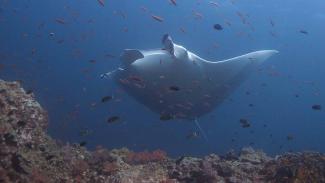
Komodo National Park Snapshot
- When to go: High season is from May through to October, but can be dived throughout the year.
- Marine life highlights: Manta Rays, numerous species of Shark, Dugong.
- How to reach: Most liveaboard departures begin and end in Labuanbajo, with limited options from Bali.
- Prices guide: Liveaboards begin from around USD170 per day, rising in luxury to over USD400 per day.
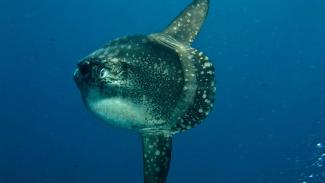
Isle Reijs & Jon Noud Hutten
Nusa Peninda Snapshot
- When to go: High season is from May through to October, but can be dived throughout the year. Mola Mola are most commonly seen from July through to September.
- Marine life highlights: Mola Mola, Manta Ray, Turtle.
- How to reach: Fly to Denpasar in Bali. We recommend to stay in Sanur or Nusa Lembongan.
- Prices guide: Accommodation starts from around USD30 per night, plus diving. More luxurious options are upwards of USD150 per night.
Tubbataha, Philippines
Located in the center of the Sulu Sea and only accessible by liveaboard during a short season fro April through to June, the Tubbataha Marine Park is without doubt one of Asia's finest destinations for thrilling big fish encounters. The plunging reefs attract numerous species of shark, including Grey Reef Sharks, Hammerheads and, in May and June, Whale Sharks. Manta Rays are also seen here, along with large numbers of turtles and plentiful pelagics.
How to dive Tubbataha
Tubbataha can only be dived by liveaboard due to its remote location, with liveaboards departing from Puerto Princessa in Palawan. The crossing to Tubbataha is long and can be rough, so a sturdy steel-bottomed liveaboard is best suited to these waters.
Options include the highly regarded Sea Doors vessel, the outstanding Solitude One or the new Philippines Aggressor. Those on a tighter budget may wish to consider the Azalea or the Resolute. All are available to book via the team at Liveaboard.com. Booking early is recommended due to high demand and a short diving season.
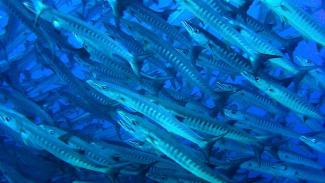
Tara North
Tubbataha Snapshot
- When to go: Accessible by liveaboard from April through to June.
- Marine life highlights: Numerous shark species, Manta Rays, Pelagics.
- How to reach: Join a liveaboard from Puerto Princessa.
- Prices guide: Liveaboards begin from around USD160 per night, but most options are upwards of USD250 per night.
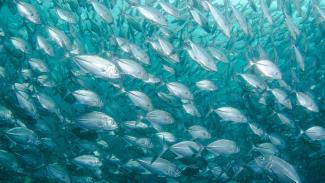
Jean Wimmerlin
Kimbe Bay Snapshot
- When to go: Can be dived from resort all year, but best months are from April to October.
- Marine life highlights: Plentiful shark species, Manta Rays, Pelagics.
- How to reach: Liveaboards depart from Walindi Plantation Resort. Fly to Hoskins via Port Moresby.
- Prices guide: Liveaboards begin from around USDXXX per night.
Maratua, Indonesia
On the Indonesian coast of Borneo, a little south from the famous Sipadan area is another area with fantastic diving. Here, a small island called Sangalaki attracts large numbers of Manta Rays, which gather to feed opn the plankton rich waters. It is even possible to encounter rare all-black Manta Rays here, as well as the more usual black & white variety.
How to dive Maratua
Maratua has some good dive resorts such as Maratua Paradise Resort and Nabucco Island Resort. However liveaboards also now visit this region and may be the better option to fully explore the area.
With the widest choice of liveaboards available and a best price guarantee, we recommend to book your liveaboard adventure with the team at liveaboard.com.
The White Manta visits the region between June and September each year and is a superbly rated modern liveaboard. She tends to offer 6 night itineraries.
The elegant Ondina is another recommended option, focusing on this area in similar months and offering slightly longer 8 night itineraries. Renovated in 2014, she is built in a traditional Phinisi style.
The Ambai is another outstanding liveaboard visiting this area annually from late May through to September and offers itinerary options from 9 to 11 nights.
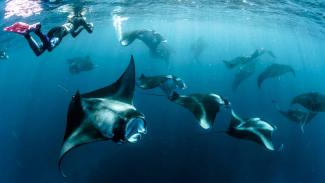
Sebastian Pena Lambarri
Maratua Snapshot
- When to go: High season is from April through to October, but can be dived throughout the year from resort with the exception of January. Liveaboards tend to visit the region from late May through to September.
- Marine life highlights: Manta Rays, Sharks, Pelagics.
- How to reach: Fly to Berau via Balikpapan.
- Prices guide: Accommodation starts from around USD50 per night, plus diving and transfers from Berau (set days only). Liveaboards begin from around USD240 per night.
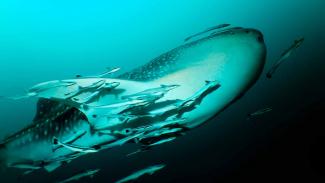
Southern Leyte Snapshot
- When to go: Can be dives all year. Whale Sharks are seen in the area primarily in April and May.
- Marine life highlights: Whale Sharks..
- How to reach:Fly to Manila and take an onward flight to Tacloban. From here it is a three hour transfer to Southern Leyte, which your resort can assist you with. Alternatively, there are ferry services from Cebu and Bohol. Liveaboards usually begin in Cebu.
- Prices guide: Accommodation starts from around USD40 per night, plus diving and transfers.. Liveaboards begin from around USD180 per night.
Burma Banks, Myanmar
These submerged sea mounts, which are a stop-off for Liveaboards from Thailand are simply a magnet for larger marine life. It is possible to see a variety of Sharkshere, from little Blacktips to Silvertips, Hammerheads and even occasional Tiger Sharks. Not too far away, Mergui Archipelago also has some great fish encounters, especially Mantas, Mobulas & Eagle Rays.
How to dive Myanmar
Myanmar can be dived from liveaboard, with liveaboard vessels departing from the Andaman (west) coast of Thailand and heading north into Myanmar. Departures are usually offered between January and March each year. Itineraries are available to book on the Smiling Seahorse and the Phinisi through liveaboard.com
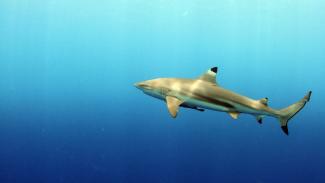
Pacific Klaus
Myanmar Snapshot
- When to go: November through to April, however liveaboard departures often January to March only.
- Marine life highlights: Blacktip Shark, Silvertip Shark, Manta Ray
- How to reach: Join a liveaboard from Chalong (Phuket), Khao Lak or Ranong.
- Prices guide: Myanmar liveaboards begin from around USD115 per day. Bear in mind there are entry fees to pay of USD250 per person.

Kris Michael Krister
Layang Layang Snapshot
- When to go: March to August each year. Hammerheads seen in April and May.
- Marine life highlights: Hammerhead Sharks, Turtles, Pelagic species
- How to reach: Resort charter flight from Kota Kinabalu two or three times per week.
- Prices guide: A 6 day, 5 night diving package costs from USD2250 with Dive the World, including flights from Kota Kinabalu. Surcharges apply for the peak hammerhead period.
You might also enjoy...
Muck diving meccas
If you are an avid underwater photographer or a lover of the weird and wonderful, then the seas of Asia hold a treasure trove of delights.
Originally pioneered in Papua New Guinea, muck-diving is now all the rage, and incredibly addictive. As the epicentre of the world's marine biodiversity, there are exceptional opportunities throughout South-east Asia.
Scuba diving in Borneo - 7 key questions answered
Tara North
For most people, Borneo conjures up visions of pristine rainforests and incredible wildlife encounters. This is all true, however for scuba divers, the magic continues beneath the blue.
Scuba diving in Borneo promises world-class dive sites, vibrant reefs and incredible marine life, from the green turtles of Sipadan Island to remote and spectacular diving in Borneo Indonesia.
Southeast Asia liveaboard diving
Surita Budiman


